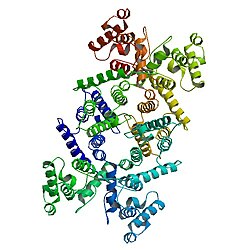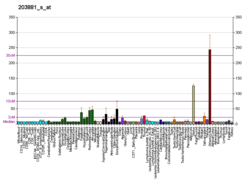ジストロフィン
ジストロフィン (dystrophin) は棒状の細胞質タンパク質で、コスタメアとして知られるタンパク質複合体の一部をなす。この複合体は細胞膜を越えて、筋繊維の細胞骨格とその周囲の細胞外マトリックスを接続している。コスタメアには他にα-ジストロブレビン・シンコイリン・シネミン・サルコグリカン・ジストログリカン・サルコスパンなど多くのタンパク質がある。
ジストロフィン遺伝子はX染色体に存在する。この遺伝子はヒトの遺伝子としてDNAレベルで最も長く、220万塩基(ヒトゲノムの0.07%)もの長さがある。一次転写産物は約240万塩基になり、転写には16時間かかる[5]。成熟mRNAは約14,000塩基となる[6]。79のエクソンにコードされ[7]、3500以上のアミノ酸からなる[8]。だが、ヒト最大のタンパクはチチンである。
病理
[編集]ジストロフィンの欠損は一部のミオパチーの原因となり、総称して筋ジストロフィーと呼ばれる。1986年に、ある遺伝子の変異がデュシェンヌ型筋ジストロフィー (DMD) を引き起こすことが明らかになり[9]、1987年にLouis M. Kunkelによって、その産物であるこの細胞質タンパク質が同定された[10]。
通常の骨格筋組織は少量の(全タンパク質の0.002%)ジストロフィンを含むのみだが、その欠損・変異は細胞内シグナル伝達系の異常をもたらし、不可逆的な筋繊維壊死・筋力低下・疲労などの症状を引き起こす。ほとんどの患者は車椅子を必要とし、心筋線維症による心臓肥大・呼吸不全の結果として20-30歳で死亡することになる。ジストロフィン遺伝子が突然変異しても部分的に機能を持つタンパクを生産できることがあり、そのような軽度の症例はベッカー型筋ジストロフィー (BMD) と呼ばれる。症状が中間的でDMDかBMDか判断しづらい場合もあるが、現在この判断にはフレームシフト突然変異の存在が用いられることが多い[11]。
未だジストロフィンの役割はよく分かっていないが、気道平滑筋細胞においてジストロフィン-糖タンパク複合体 (DGC) がその収縮に不可欠であることを示した研究がある[12]。
相互作用
[編集]β1-シントロフィン[13]・α1-シントロフィン[14][15][16]・α-ジストロブレビン[17]とタンパク質間相互作用する。
出典
[編集]- ^ a b c GRCh38: Ensembl release 89: ENSG00000198947 - Ensembl, May 2017
- ^ a b c GRCm38: Ensembl release 89: ENSMUSG00000045103 - Ensembl, May 2017
- ^ Human PubMed Reference:
- ^ Mouse PubMed Reference:
- ^ Tennyson CN, Klamut HJ, Worton RG (1995). “The human dystrophin gene requires 16 hours to be transcribed and is cotranscriptionally spliced”. Nature Genetics 9 (2): 184-90. doi:10.1038/ng0295-184. PMID 7719347.
- ^ NCBI Sequence Viewer v2.0
- ^ Strachan T and Read AP, 1999. Human molecular genetics, BIOS Scientific, New York, USA
- ^ NCBI Sequence Viewer v2.0
- ^ Monaco A, Neve R, Colletti-Feener C et al. (1986). “Isolation of candidate cDNAs for portions of the Duchenne muscular dystrophy gene”. Nature 323 (6089): 646–50. doi:10.1038/323646a0. PMID 3773991.
- ^ Hoffman E, Brown R, Kunkel L (1987). “Dystrophin: the protein product of the Duchenne muscular dystrophy locus”. Cell 51 (6): 919–28. doi:10.1016/0092-8674(87)90579-4. PMID 3319190.
- ^ Aartsma-Rus A, et al. (2006). “Entries in the Leiden Duchenne muscular dystrophy mutation database: an overview of mutation types and paradoxical cases that confirm the reading-frame rule”. Muscle Nerve 34 (2): 135–44. doi:10.1002/mus.20586. PMID 16770791.
- ^ Sharma P, Tran T, Stelmack GL, et al. (2008). “Expression of the dystrophin-glycoprotein complex is a marker for human airway smooth muscle phenotype maturation”. Am. J. Physiol. Lung Cell Mol. Physiol. 294 (1): L57–68. doi:10.1152/ajplung.00378.2007. PMID 17993586.
- ^ Ahn, A H; Kunkel L M (Feb. 1995). “Syntrophin binds to an alternatively spliced exon of dystrophin”. J. Cell Biol. (UNITED STATES) 128 (3): 363–71. doi:10.1083/jcb.128.3.363. ISSN 0021-9525. PMC 2120343. PMID 7844150.
- ^ Ahn, A H; Freener C A, Gussoni E, Yoshida M, Ozawa E, Kunkel L M (Feb. 1996). “The three human syntrophin genes are expressed in diverse tissues, have distinct chromosomal locations, and each bind to dystrophin and its relatives”. J. Biol. Chem. (UNITED STATES) 271 (5): 2724–30. doi:10.1074/jbc.271.5.2724. ISSN 0021-9258. PMID 8576247.
- ^ Yang, B; Jung D, Rafael J A, Chamberlain J S, Campbell K P (Mar. 1995). “Identification of alpha-syntrophin binding to syntrophin triplet, dystrophin, nNOS NOS1 ,and utrophin”. J. Biol. Chem. (UNITED STATES) 270 (10): 4975–8. doi:10.1074/jbc.270.10.4975. ISSN 0021-9258. PMID 7890602.
- ^ Gee, S H; Madhavan R, Levinson S R, Caldwell J H, Sealock R, Froehner S C (Jan. 1998). “Interaction of muscle and brain sodium channels with multiple members of the syntrophin family of dystrophin-associated proteins”. J. Neurosci. (UNITED STATES) 18 (1): 128–37. ISSN 0270-6474. PMID 9412493.
- ^ Sadoulet-Puccio, H M; Rajala M, Kunkel L M (Nov. 1997). “Dystrobrevin and dystrophin: an interaction through coiled-coil motifs”. Proc. Natl. Acad. Sci. U.S.A. (UNITED STATES) 94 (23): 12413–8. doi:10.1073/pnas.94.23.12413. ISSN 0027-8424. PMC 24974. PMID 9356463.
参考文献
[編集]- Roberts RG, Gardner RJ, Bobrow M (1994). “Searching for the 1 in 2,400,000: a review of dystrophin gene point mutations”. Hum. Mutat. 4 (1): 1–11. doi:10.1002/humu.1380040102. PMID 7951253.
- Tinsley JM, Blake DJ, Zuellig RA, Davies KE (1994). “Increasing complexity of the dystrophin-associated protein complex”. Proc. Natl. Acad. Sci. U.S.A. 91 (18): 8307–13. doi:10.1073/pnas.91.18.8307. PMC 44595. PMID 8078878.
- Blake DJ, Weir A, Newey SE, Davies KE (2002). "Function and genetics of dystrophin and dystrophin-related proteins in muscle". Physiol. Rev. 82 (2): 291–329. doi:10.1152/physrev.00028.2001 (inactive 22 June 2008). PMID 11917091。
- Röper K, Gregory SL, Brown NH (2003). “The 'spectraplakins': cytoskeletal giants with characteristics of both spectrin and plakin families”. J. Cell. Sci. 115 (Pt 22): 4215–25. doi:10.1242/jcs.00157. PMID 12376554.
- Muntoni F, Torelli S, Ferlini A (2003). “Dystrophin and mutations: one gene, several proteins, multiple phenotypes”. Lancet neurology 2 (12): 731–40. doi:10.1016/S1474-4422(03)00585-4. PMID 14636778.
- Haenggi T, Fritschy JM (2006). “Role of dystrophin and utrophin for assembly and function of the dystrophin glycoprotein complex in non-muscle tissue”. Cell. Mol. Life Sci. 63 (14): 1614–31. doi:10.1007/s00018-005-5461-0. PMID 16710609.
外部リンク
[編集]- GeneReviews/NCBI/NIH/UW entry on Dystrophinopathies
- Dystrophin - MeSH・アメリカ国立医学図書館・生命科学用語シソーラス
- LOVD mutation database: DMD, DMD (whole exon changes)
 ウィキメディア・コモンズには、ジストロフィンに関するカテゴリがあります。
ウィキメディア・コモンズには、ジストロフィンに関するカテゴリがあります。










